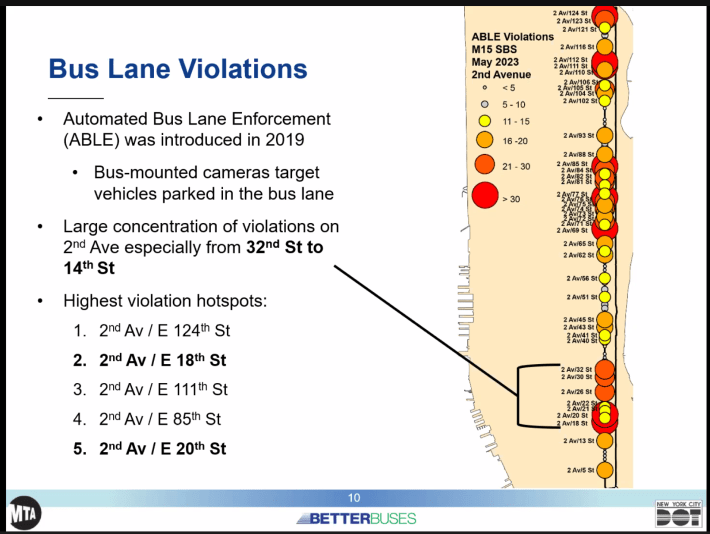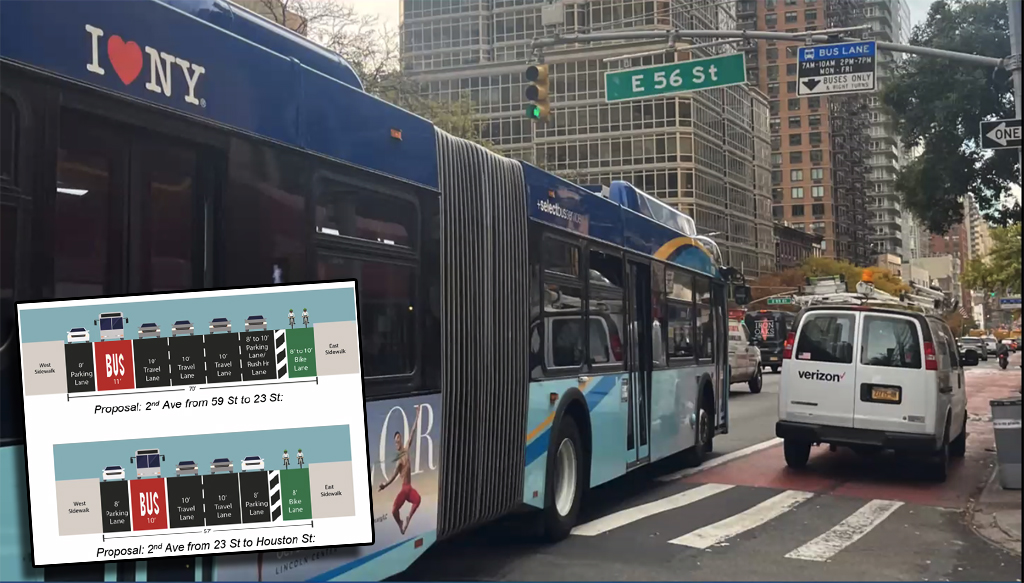If you can't beat 'em, paint around 'em.
The Department of Transportation will move the dedicated rush-hour bus lane on Second Avenue from the curbside lane, where it is frequently blocked by NYPD vehicles and other cars, and repaint it one lane over — a plan that the agency says will improve transit along the nation's busiest bus route.
The plan [PDF] also calls for DOT to bolster the bus lane to 24 hours a day, seven days a week, up from the current operating hours of 7-10 a.m. and 2-7 p.m. on weekdays. In addition, the agency will widen the Second Avenue bike lane, one of the city's busiest, from its current six-foot width to eight feet south of E. 23rd Street and to eight to 10 feet between E. 59th and 23rd streets, a move that will increase capacity and allow safe passing by faster e-bikes, the agency said.

Manhattan Community Board 6's Transportation Committee's nine members unanimously approved the plan after a presentation by the agency and the MTA, both of which promised faster bus speeds for the 57,000 people who use buses on Second Avenue every day — and are currently burdened with speeds that average just 5.5 miles per hour along the stretch between 59th and Houston streets.
Neither the DOT nor the MTA mentioned the elephant in the room — the NYPD officers who leave vehicles, equipment and their own cars in the bus lane south of 23rd Street, the recent focus of a Streetsblog video:
But members of the committee consistently blamed the NYPD and its employees, the very people who are supposed to enforcing the lane to keep it clear.
NYPD lawlessness was the very first comment raised by committee Chair Jason Froimowitz, who asked about dismissal rates of tickets written by automated cameras to NYPD vehicles in the bus lane. The board has long sought to get the NYPD out of its bus lane.
Neither DOT nor MTA provided an answer. (The NYPD has ignored several requests for comment from Streetsblog on the agency's repeated illegal parking on Second Avenue.)

Setting aside the fact illegal parking by DOT's "Vision Zero Partner" agency is one of the reasons for Monday's presentation, the redesign is a victory for cycling and transit advocates who have long been calling for better bus and bike lanes on the strip.
Streetsblog and Streetfilms have documented unsafe biking conditions and demonstrated that there are often more cyclists than drivers on the roadway. Other cities have solved the problem — and created a virtuous circle of more cycling — by widening bike lanes.
Elected officials in New York began calling for a wider Second Avenue bike lane in 2021, citing DOT's own statistics that the vast majority of road users on the corridor are in buses and on bikes.
Similarly to the bike lane, the benefits of the Second Avenue bus lane have degraded over time, albeit not to more buses, but to illegal parking, the DOT said.
"While we saw initial speed improvements with the curbside lanes, but over time those gains have eroded," said Rachel Eisenberg of the DOT, not mentioning the NYPD.
MTA presenter Laura Azze-Singh also neglected to mention the NYPD, saying only that "curbside bike lanes are more likely to be blocked by parked vehicles than offset lanes." She did show a map of where MTA cameras pick up scofflaw vehicles — and the hot zone is exactly where the NYPD blocks the lane:

Several members of the committee raised substantive issues, including the fear raised by Board member Gabe Turzo that creating more parking spaces by moving the bus lane off the curb will induce more driving. The presence of more parking has been shown repeatedly to increase driving and car ownership.
Eisenberg only said she would "talk to our parking unit" about it. (DOT did not immediately respond to a question after hours on Monday night from Streetsblog about this issue, but earlier had said that not all of the new spaces would be for parking, but some would be used as loading zones.)
Most important, said Eisenberg is that an offset lane won't be blocked as frequently by cars in the bus lane itself, which could mean a better experience for drivers, even as the roadway has one fewer lane for moving vehicles. "Better lane organization and better curb management will help vehicles get through," she said.
And board member Mariam Rauf pointed out that there might be a critical flaw: at stops, the bus will leave its dedicated lane to pull over to the curbside bus stop, which, she said, would likely be filled with cars "taking advantage" of the no-longer-red-painted space.
Eisenberg suggested that it won't be a problem. (DOT did not respond to a question on Monday night from Streetsblog about this issue.)
And a member of the public — using the Q&A function on Zoom — asked the DOT to remove another travel lane for the booming micromobility modes that Mayor Adams has repeatedly said represent the future of travel in New York City.
Eisenberg said that Second Avenue is "an important thoroughfare for all travelers, and we are not looking at further reducing the number of lanes."
DOT says it will complete the work this spring. In a statement, DOT Commissioner Ydanis Rodriguez said the work would not only "make commutes faster" and "better protect the increasing number of cyclists," but also that the improvement signifies that "New York City DOT is putting people first on Manhattan’s avenues.”
Pedestrians will also get concrete refuge islands under the plan.






